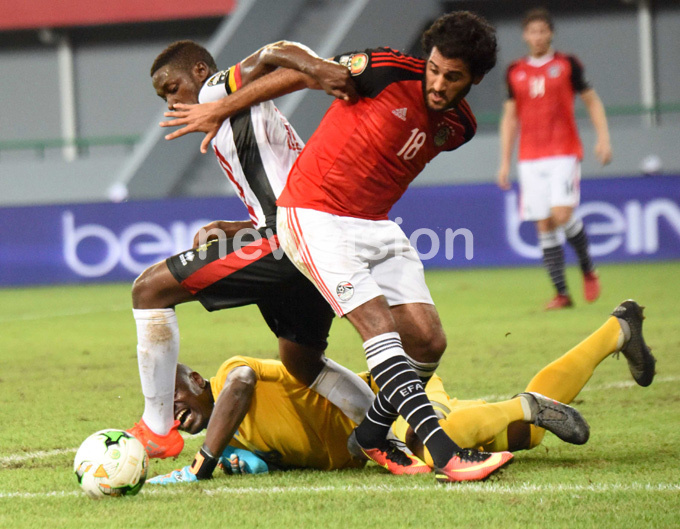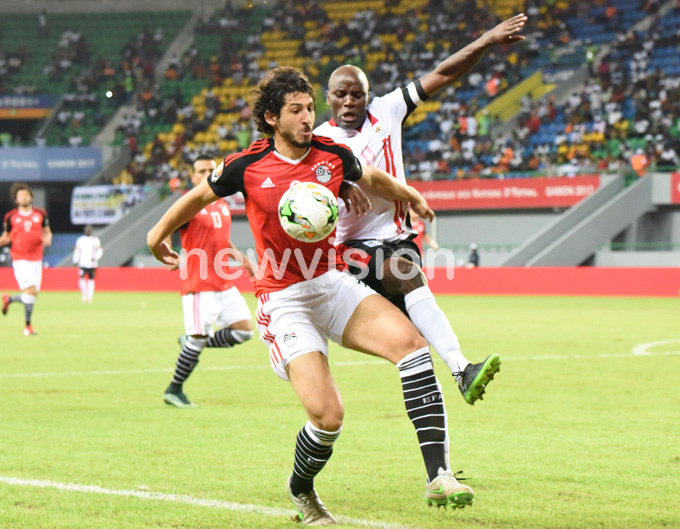Defensive strategy cost Cranes
Jan 23, 2017
At the final whistle, Tony Mawejje sunk to his knees, while Geoffrey Kizito collapsed flat in a heap.

Total Africa Cup of Nations
Group D results
Uganda 0 Egypt 1
Ghana 1 Mali 0
Wednesday
Ghana v Egypt 9pm
Uganda v Mali 9pm
Uganda's hopes of emulating the historic Cranes side that stunned Africa and stormed the finals in 1978 ended in heartbreaking fashion here on Saturday.
At the final whistle, Tony Mawejje sunk to his knees, while Geoffrey Kizito collapsed flat in a heap.
Yards away, Godfrey Walusimbi, the man beaten by Mohammad Saalah's brilliant pass, that set-up Abadallah El-Said, for the all-important goal looked on sheepishly.

All three, just like their Cranes teammates, had given their all over 90 minutes and yet still couldn't find a way past their customary oppressors Egypt.
Cranes 1-0 defeat, and overall display, was certainly an improvement from the 3-0 and 3-1 defeats Uganda had suffered at the hands of Egypt in their previous friendly matches in 2012.
And yet still, despite the improvement, the Pharaohs still managed to fix a spanner in Cranes' hopes of making the knock-out sages, with the final Group D fixture against Mali on Wednesday now a formality.
But where did it all go wrong?
You would say that the nature of Cranes' collapse on Saturday was the sort of scenario Ugandans dreaded and yet half-expected for two simple reasons -a lack of tactical astuteness and creative figure in the team.

In the build-up to this game, there was particular interest in how Coach Micho Sredojevic would set-up his side given the return of Murushid Juuko and Khalid Aucho from suspension.
Still angered by the nature of the defeat to Ghana, the Serbian chose to drop defender Isaac Isinde for his error against the Black Stars, and played Juuko alongside robust Hassan Wasswa.
Walusimbi also started at left-back with Ochaya pushed to a more offensive role on the left.
With Kizito seated in holding midfield, Mawejje and Aucho were assigned to dictate proceedings going forward. Aucho was meant to join Kizito when Cranes lost the ball, and then join Mawejje when Cranes had possession in a 4-2-3-1 formation that looked more defensive in composition.
Although Cranes occasionally managed to go forward, the make-up of the team could hardly allow Farouk Miya and lone striker Geoffrey Massa threaten the Pharaohs.

Egypt made their intensions clear right from the start, dominating Cranes, and restricting them to a few counter-attacks. Onyango was forced to step in not once but twice, first saving a tricky ball off Marawan Fahmy's feet, and then with a headed clearance after his central defensive pair had been beaten.
Between both moments, Cranes almost caught out Egypt.
Egypt defender Ahmed Hegazy almost deflected Joseph Ochaya's in-swinger into his own net, while Miya threatened but his two efforts on goal were too fragile to stretch veteran goalkeeper Essam El-Hadary.
Change of strategy
In a first half that Egypt had dominated proceedings, Cranes still managed to test and should have noted that 44 year-old goalkeeper El-Hadary was past his best.
Hadary spilled two balls that a fit goalkeeper wouldn't -which meant that with more crosses behind the Egyptian defense, the Cranes would have forced the Pharaohs into serious problems.
But Micho chose to start his wide players on the bench.
He abandoned his previous system, where fullbacks often look more like wingers, for a compact midfield but with no inventiveness going forward.
Denis Iguma and Godfrey Walusimbi have served Cranes well before. The pair also did their bit against the Pharaohs in the first half, holding out their lines and frustrating Egyptian wingers Ahmed Ibrahim and Ahmed Ramadan, but with limitations venturing forward.
And considering that Egypt had fizzled out into the second half, just as Ghana did in the first game, it would have been reasonable to consider a more adventurous approach with the likes of Moses Oloya, Luwagga Kizito replacing two of the full-backs or one of the three defensive midfielders.
Wadada came on as a second-half replacement for Miya, but just like Ochaya, who has never performed optimally as a winger, could have done wonders if they had operated from defensive positions.
Both Ochaya and Wadada have pace and dribbling ability of elite full-backs. The runs they make out wide are often key to opening-up opposing defenses.
They throw themselves into tackles and run up and down the sideline with such intensity; that could have stretched Egypt.
No creative player
The decision to drop Muzamir Mutyaba in a way haunted Cranes as well at this championship.
Over the last couple of months, there have been several calls to drop team captain Geoffrey Massa.
But that's a call Micho must have found tricky considering the experience that Massa brings to the side.
He is also aware that Cranes attacking players do not operate optimally because of the lack of creativity in the final third.
Youngster Mohammed Shaban looked isolated after coming on. Midfielders Mawejje, Kizito and Aucho couldn't find him with that final pass because that isn't their staple diet.
Over the years, Cranes have failed to find a playmaker - a player in the mold of Jamil Kyambadde or Hakim Magumba that would allow strikers the liberty of scoring.
Throughout Cranes qualifying campaign, it took a moment of individual brilliance in every other game to earn Uganda victories.
But then such individual moments are rare, the more reason Micho had to find alternatives. The closes in the Azam Uganda Premier League is Muzamir Mutyaba.
Midfielders Mawejje, Aucho, Geoffrey Kizito and Mike Azira are brilliant lieutenants for the team but lack the cutting edge that Mutyaba -dropped from the 23 -could have probably provided.
All four possess the ball but without the industry to release the front two attacking pair with that final ball behind the defence -the kind that could have preserved Uganda's prospects here.
